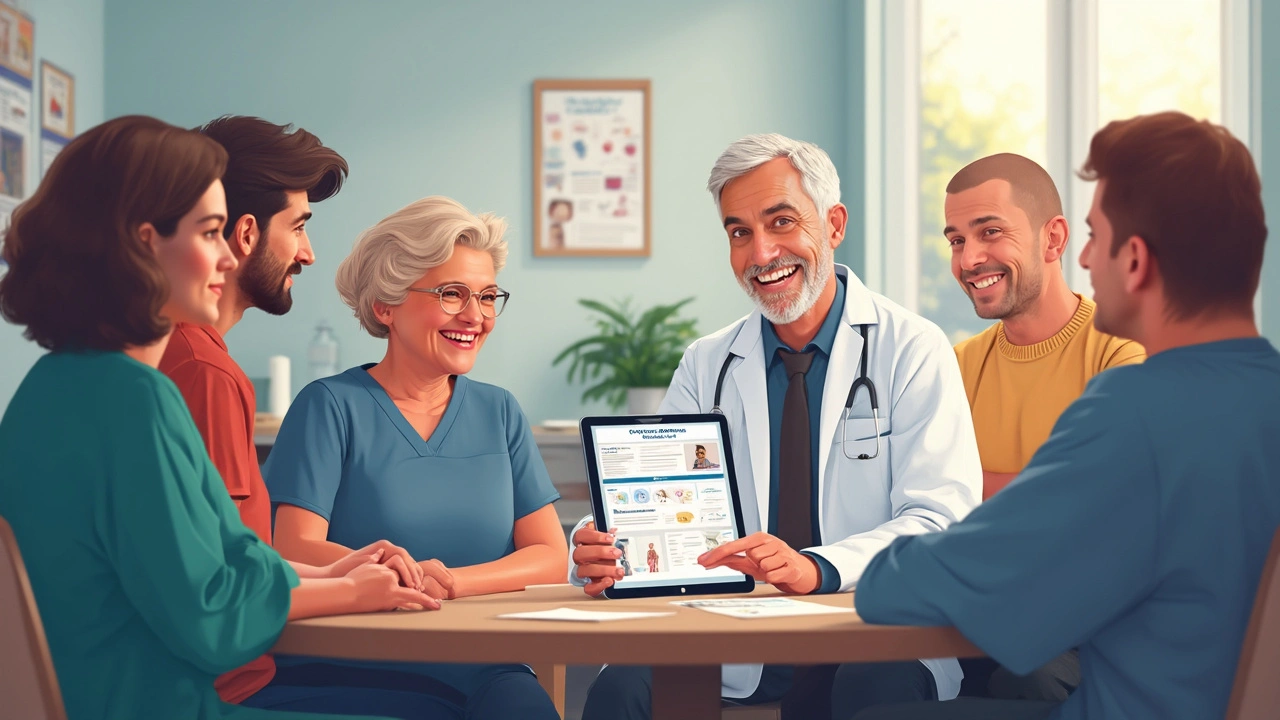Think blood pressure treatment’s all the same? Cozaar (known generically as losartan) manages to break the mold. It’s been on doctor’s radars since the late 1990s and still pops up on scripts across Melbourne and beyond. If you’ve been told to start it—or even just found a box in your parents’ bathroom—you’re probably wondering what the fuss is about.
What Exactly Is Cozaar and How Does It Work?
Cozaar, with its generic name losartan, isn’t your typical blood pressure pill. It’s classified as an angiotensin receptor blocker (ARB for short). But what does that really mean for your body? Unlike older classes like beta-blockers or ACE inhibitors, Cozaar deals directly with a hormone called angiotensin II. This hormone’s a bit of a troublemaker—it squeezes down your blood vessels, raising your blood pressure and making your heart work overtime. Cozaar steps in as the bouncer, locking angiotensin II out of its usual hangouts. Veins and arteries relax, the heart chills out, and your blood pressure slips into the safe zone.
Here’s a wild fact: in the past, options for blood pressure management were more likely to cause coughing fits or swelling. Cozaar changed that. Its side effect profile is more forgiving for a lot of people—making it a quiet hit for those who can’t handle ACE inhibitors. Want some numbers? In Australia, ARBs like Cozaar are among the top three most prescribed antihypertensive drugs, right up there with calcium channel blockers and ACE inhibitors. That should tell you something about its popularity and staying power in real-world medicine.
But Cozaar doesn’t just stop at blood pressure. It’s shown up in clinics for people with diabetic kidney disease, stroke prevention, and even some cases of heart failure. That’s quite a resume for a small pill. The magic is how it reduces strain on the kidneys—especially if you’ve got diabetes pushing your numbers up. In studies, losartan not only lowered protein in the urine (a sign of kidney stress), but also helped slow the march toward more serious kidney problems.
Who Should (and Shouldn’t) Take Cozaar?
So, who lands a Cozaar script? Doctors look at more than just high readings. If you’re pushing past 140/90 mmHg on the monitor—or you’ve got diabetes, chronic kidney disease, or a history of strokes—losartan comes onto the radar. In Aussie clinics, it’s a go-to for people who either can’t handle ACE inhibitors or need an extra boost alongside other meds.
There’s a flip side, of course. Cozaar isn’t handed out like lollies. There are a few people who should give it a wide berth. Pregnant women, for a start—the risk to unborn babies is too high. People with serious kidney problems (like severe renal artery stenosis) should double-check with their specialist before touching it. And if lab tests show you’re running low on potassium or your kidneys aren’t pulling their weight, your doc might look elsewhere or keep a close eye if they do prescribe it.
Think you’re a candidate? A quick scan at the pharmacy shelf and you’ll spot dosages like 50mg and 100mg. Your doctor will usually start you off low, see how you settle, and kick things up if your blood pressure’s not budging. There’s no one-size-fits-all here. One tip: always ask for a kidney function test before you start, and again a few weeks later. Your kidneys can sometimes react quietly. Catching problems early lets you sidestep any dramas.

Day-to-Day Tips for Taking Cozaar
Let’s get down to brass tacks. If Cozaar’s heading for your morning routine, there are a few hacks to sidestep the usual slip-ups. First, pick a time—morning with breakfast works for most people because it keeps the routine steady. If you forget and remember in the afternoon, it’s better to take it late than to skip, unless you’re way too close to the next dose.
Alcohol and Cozaar don’t play nicely together. A glass of shiraz won’t send you off the rails, but too much alcohol can cancel out your progress. So keep it sensible. And if the thought of that little tablet makes you feel queasy, you can take it with food—no dramas.
Hydration matters more than you’d think. If you’re sweating buckets on the tram or during footy practice, Cozaar can bump up the risk of low blood pressure. Dizziness, leg cramps, or even fainting just aren’t worth the risk. Keep a bottle handy, especially when Melbourne’s summer turns up the heat.
Another clever move: keep a blood pressure diary. Apps or old-school notebook, doesn’t matter. Record numbers a few times per week at the same time. Print it out or email it before your GP check-up—makes adjusting your dose way easier.
Side Effects and Cautions: What to Look Out For
No medicine is golden, and Cozaar has its own list of possible gremlins. The good news is, fewer folks mention the infamous dry cough tied to ACE inhibitors. Still, you can get other glitches. Dizziness is the big one, especially when you first start or after a dose bump.
Potassium levels can creep up, especially if you’re taking supplements or eating loads of bananas or avocado. High potassium can mess with your heart rhythm, so if you feel muscle weakness or palpitations, flag it with your doctor straight away. Unusual tiredness, flu-like symptoms, or a rash are rare but worth knowing about.
Some people notice a mild headache or stomach upset in the first week, but these usually fade. What’s less common but still possible? Swelling of the lips or face, which is a medical emergency—call for help if it happens.
Aussie health authorities recommend checking kidney function and salts (like potassium and sodium) about a month after starting, then once or twice a year. In 2024, a Queensland study of over 2,000 patients showed that sticking to this testing schedule sharply cut down hospital visits for unexpected side effects.
Here’s a handy table showing common side effects and their frequencies, straight from local registries:
| Side Effect | Estimated Frequency (%) |
|---|---|
| Dizziness | 6 - 9 |
| High potassium | 1 - 3 |
| Headache | 2 - 4 |
| Cold-like symptoms | 5 |
| Serious allergic reaction | <1 |
Drugs can interact with Cozaar, too. Watch out for painkillers like ibuprofen—they can strain your kidneys when combined with ARBs. Salt substitutes are sneaky—they often hide potassium. Check any over-the-counter supplements with your pharmacist just to be safe.

Living With Cozaar: Real-Life Stories & Practical Advice
The truth is, most people on Cozaar manage just fine—and for many, it’s a godsend after struggling with side effects from other meds. I met a bloke at my local coffee shop who stopped going for daily walks because his old tablets left him coughing nonstop. Switched to Cozaar, and within two weeks, he was back on the walking trail with his golden retriever. Stuff like that doesn’t show up in clinical trials, but it matters in real life.
Pairing Cozaar with lifestyle tweaks pays off. That means cutting the salt, staying active, and keeping an eye on your weight. My mum, who’s been on losartan for five years, swears by her twice-weekly yoga and a strict rule: no chips in the house.
Here’s one thing hardly anyone mentions: prescription costs. With the PBS in Australia, Cozaar’s price drops to less than $10 per monthly script for most people, making it pretty affordable compared to some newer blood pressure meds.
Melbourne’s General Practitioners often talk about the "triple approach": medication, movement, and meals. They’ll sometimes suggest a home blood pressure monitor to keep you on track. It might feel like a hassle at first, but it gives your doctor a clear idea if Cozaar’s doing its job or if it’s time to tinker with your regimen.
If you travel or have a hectic schedule, pack your pills in a day-of-the-week container. Sounds simple, but it cuts down forgotten doses sharply—one less thing to worry about.
Cozaar has earned its place as a go-to blood pressure fixer, not just in Australia but around the world. There’s still research bubbling up—like combo pills with other drugs—showing promise in making control even easier. For most, the right dose plus smart lifestyle changes unlocks a steadier, healthier routine. Stay curious, stay informed, and don’t be afraid to ask questions at the next check-up.









Rose Macaulay
I started Cozaar last year and honestly? The dizziness hit me hard the first week, but I stuck with it. Now I feel better than I have in years.
William Cuthbertson
It’s fascinating how a molecule as simple as losartan can rewire the body’s entire stress-response architecture. Angiotensin II isn’t just a vasoconstrictor-it’s a hormonal echo of chronic anxiety, and blocking it doesn’t just lower BP, it lowers the ambient tension in your entire physiology. We treat hypertension like a mechanical issue, but it’s often the body screaming for peace. Cozaar doesn’t just silence the noise-it gives the system permission to rest.
And let’s not forget the kidney protection. In cultures where diabetes runs rampant, this isn’t just medicine-it’s a quiet act of cultural preservation. My grandfather in Manchester had diabetic nephropathy; Cozaar bought him five extra years of watching cricket on the porch without dialysis. That’s not a statistic. That’s legacy.
Compare that to the old-school beta-blockers that made you feel like a zombie with a slow heartbeat. Cozaar doesn’t numb you. It restores you. It’s the difference between being medicated and being healed.
And yet, the system still pushes the expensive new stuff. Why? Because profit margins don’t care about legacy. But patients do.
The potassium warning? Valid. But it’s also a lesson in listening to your body. Bananas aren’t the enemy. Ignorance is. I know someone who took potassium supplements while on Cozaar and ended up in the ER because they didn’t check labs. No one told them. That’s the real failure-not the drug.
Hydration matters. Alcohol undermines it. Salt substitutes are landmines. These aren’t side effects-they’re life skills disguised as warnings. Cozaar isn’t a magic pill. It’s a mirror. It reflects how well you’re taking care of yourself.
I’ve seen people on this drug for 15 years. They’re not just alive-they’re thriving. Walking dogs. Traveling. Cooking for grandchildren. That’s the real efficacy data.
And yes, the cost. Under PBS, it’s cheaper than a daily latte. Imagine if every chronic med was this accessible. Imagine if healthcare prioritized sustainability over spectacle.
Cozaar isn’t revolutionary. It’s just… right. And sometimes, that’s enough.
Eben Neppie
Incorrectly implying that ARBs are universally superior to ACE inhibitors is misleading. While cough incidence is lower with losartan, the mortality benefit in post-MI patients is better documented with ACE inhibitors per multiple meta-analyses (e.g., HOPE, HOPE-TOO). Cozaar is not a first-line replacement for ACEi in all indications-only in cases of intolerance. Also, the 6–9% dizziness rate is underreported in real-world data; studies show up to 15% in elderly populations. Don’t oversimplify.
Steven Shu
Yeah, but you’re ignoring the fact that Cozaar’s renal protection is actually superior in type 2 diabetics with microalbuminuria-RENAAL trial showed 16% reduction in end-stage renal disease. ACE inhibitors don’t have that same level of proof for kidney-specific outcomes in this group. So no, it’s not just for people who can’t tolerate ACEi-it’s often the better choice if you’ve got diabetes.
Also, the potassium thing? Totally real. I had a patient who ate three avocados a day and ended up with a K+ of 6.1. We had to stop Cozaar and do emergency dialysis. This isn’t hypothetical.
Vasudha Menia
Thank you for this! 🙏 I’ve been on Cozaar for 3 years and I was terrified at first-thought I’d be on meds forever. But with yoga, less salt, and walking every morning, my BP is now normal without any other pills! You’re not broken-you’re just healing. 💪❤️
Ellen Frida
Have you ever wondered if Cozaar is secretly part of a Big Pharma plot to make us dependent on pills instead of fixing our food system? I mean, why are we all eating so much processed junk and then blaming our kidneys? Cozaar doesn’t fix the root cause-it just masks it while corporations profit. I stopped mine after reading about glyphosate and potassium interactions… and I feel better now. No meds. Just lemon water and sunlight.
Anna S.
People who take Cozaar are just lazy. If you ate real food, exercised, and stopped drinking soda, you wouldn’t need this. It’s not a miracle drug-it’s an excuse.
Milind Caspar
Let us not forget the systemic failure of Western medicine. Cozaar is a Band-Aid on a hemorrhage. The real issue is the industrialized food supply, sedentary lifestyles, and the erosion of ancestral health practices. The fact that we have millions taking ARBs while corporations sell high-fructose corn syrup as ‘breakfast’ is not a triumph of pharmacology-it is a moral collapse. The WHO estimates that 80% of hypertension is preventable through diet and activity. Cozaar is the symptom, not the solution.
And yet, we praise it. We celebrate it. We fund its marketing. We ignore the elephant in the room: the food industry pays doctors to prescribe these drugs. The same industry that makes the problem.
Check your local supermarket. Count the aisles of processed food. Then count the number of doctors who will tell you to eat more vegetables. The math is not on your side.
Cozaar will not save you. Discipline will. Food will. Movement will. Not a pill. Never a pill.
Prema Amrita
Cozaar saved my mother's kidneys. She had type 2 diabetes and proteinuria. After starting losartan, her urine albumin dropped by 70% in 6 months. No drama. No hospital visits. Just quiet, consistent healing. The PBS makes it accessible. The science is solid. Trust your doctor. Check your labs. Stay hydrated. Simple.
Robert Burruss
Interesting… I wonder… if the angiotensin receptor blockade… also affects… the… renin-angiotensin-aldosterone system’s… feedback loops… in… long-term… use…? And… what… about… the… endothelial… function… changes… over… 5+ years…? I’ve… read… a… few… papers… on… this… but… I’m… not… sure… if… the… data… is… robust… enough… to… draw… conclusions…
Alex Rose
ARBs exhibit favorable pharmacokinetics with minimal CYP450 interactions, making them ideal for polypharmacy populations. However, the risk of hyperkalemia escalates with concomitant NSAID or spironolactone use. The RENAAL and IDNT trials demonstrated significant renoprotection in diabetic nephropathy, but these were exclusionary cohorts-real-world adherence is suboptimal, and monitoring compliance remains a clinical blind spot.
Snehal Ranjan
Cozaar is not merely a medication-it is a symbol of wisdom in medical practice. In India, where diabetes is epidemic and healthcare access is unequal, the affordability of losartan under PBS-like schemes is nothing short of revolutionary. A small pill, costing less than the price of a meal, can prevent kidney failure, stroke, and heart disease. This is preventive medicine at its finest. We must celebrate such innovations, not dismiss them as Band-Aids. The true failure is not the drug, but our inability to make such treatments universally accessible. Let us not confuse convenience with complacency. Cozaar is not a crutch-it is a bridge to a healthier future.
And yes, lifestyle changes are vital. But for millions who already have hypertension, waiting for perfect habits is a luxury they cannot afford. Cozaar buys time. Time to eat better. Time to move more. Time to heal.
I have seen grandfathers in rural villages take this pill daily. They walk miles to the clinic. They measure their blood pressure with manual cuffs. They do not have apps or smartwatches. But they have Cozaar. And they are alive. That is the real metric.
Do not underestimate the dignity of a simple, effective, affordable medicine. It is not magic. But it is mercy.
Mim Scala
I’ve been prescribing Cozaar for over 12 years. The most common mistake I see? Patients stop it because they ‘feel fine.’ But hypertension is silent. You don’t feel the damage until it’s too late. I always tell my patients: ‘You’re not taking this to feel better. You’re taking it to stay alive.’
And yes-keep the diary. Even if it’s just a note on your phone. Your doctor will thank you.
Bryan Heathcote
Wait, so if I take Cozaar and eat a banana, am I gonna die? 😅 Just kidding-but seriously, I’ve been on it for 2 years and I love how I don’t have that annoying cough anymore. My old BP med made me sound like a chain-smoker at 30. Cozaar? Zero cough. Zero drama. Just steady numbers. Also, the $10 script? Yes please.
Hudson Owen
Thank you for the comprehensive and clinically grounded overview. The integration of real-world context-such as the PBS pricing structure and the importance of renal monitoring-is both thoughtful and essential. It is precisely this kind of balanced, evidence-informed communication that fosters informed patient autonomy and mitigates misinformation. The acknowledgment of lifestyle synergies, alongside pharmacological intervention, reflects a holistic model of care that should be emulated in public health discourse. I commend the author for the clarity and compassion evident in this piece.